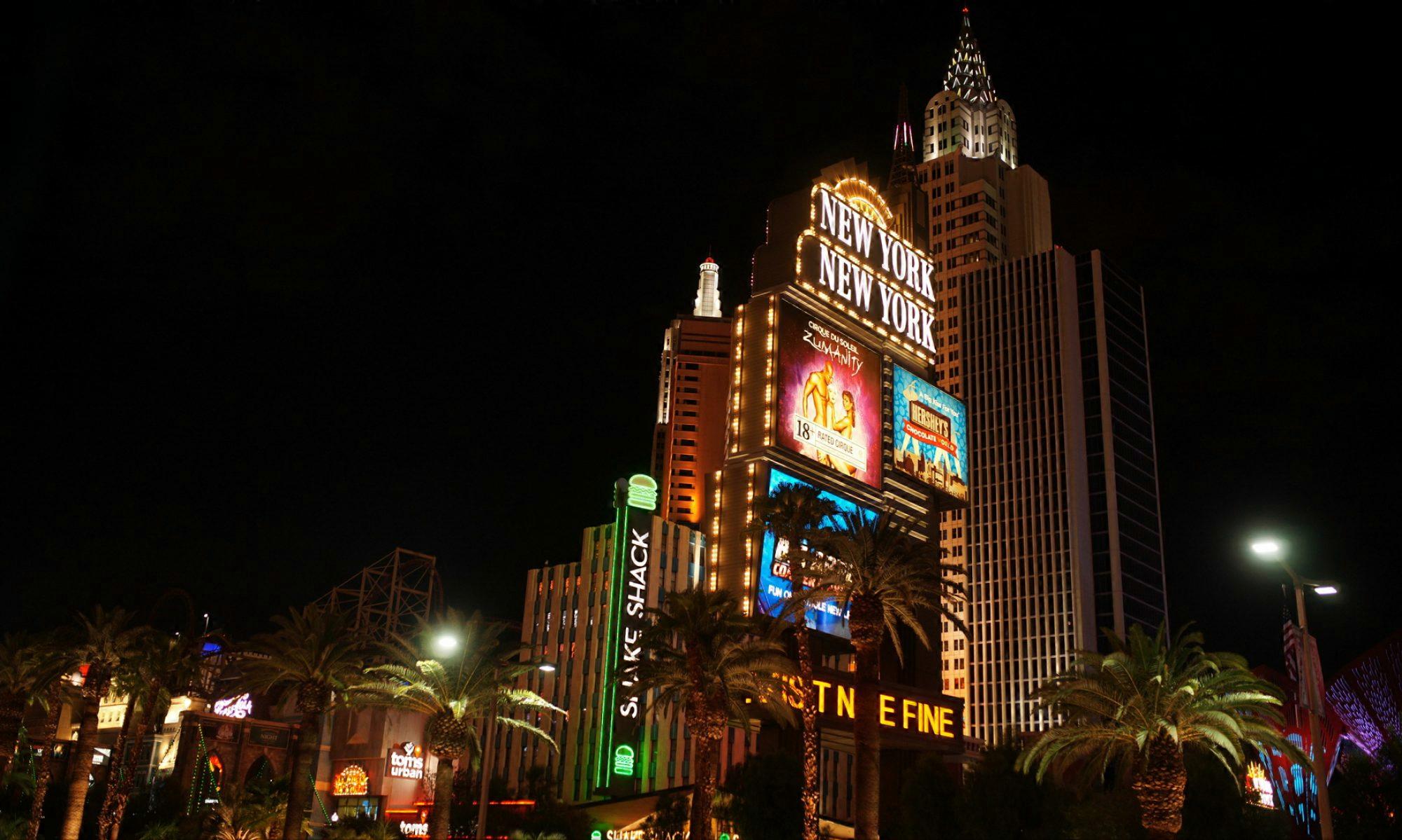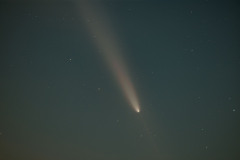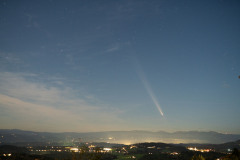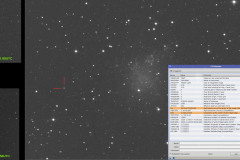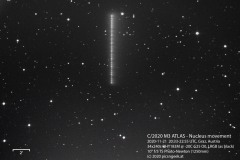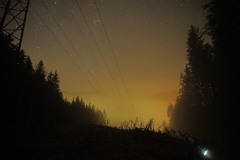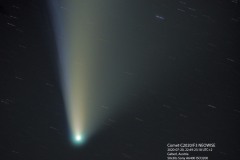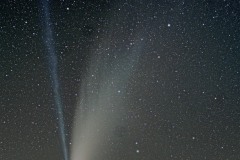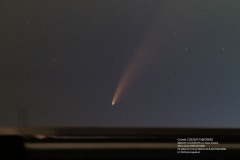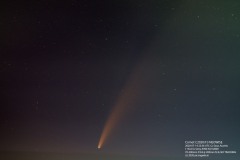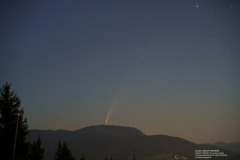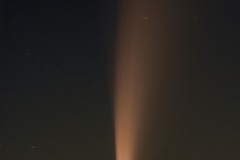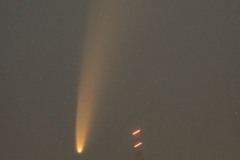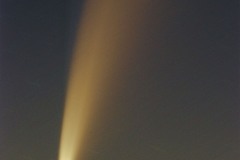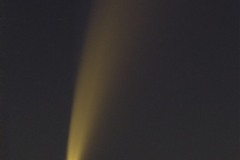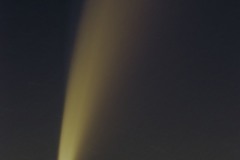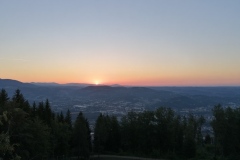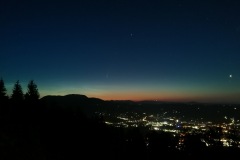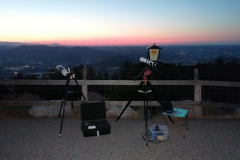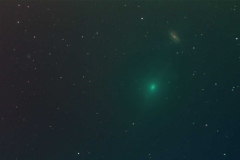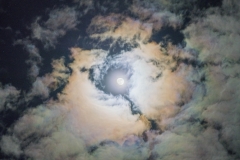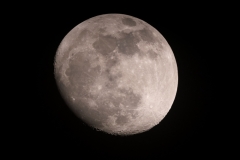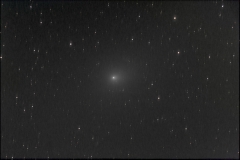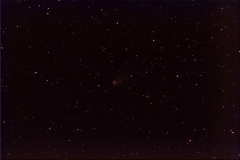Finally, the long awaited comet C2023/A3 Tsuchinschan-ATLAS reappeared after its passage close to the sun. With a well timed window between clouds, I could observe and image the comet. From all the announcements, I expected the comet to be brighter. But still, it is a naked eye comet to enjoy with a pretty long tail.
Asteroid (140) Siwa close to IC1613?
Comet C/2020 M3 ATLAS – Nucleus movement
Saturday night (2020-11-21) I recorded LRGB data of comet C/2020 M3 ATLAS. Upon inspecting the image data, I detected a spinning movement of the comets nucleus. To show the movement, I combined the 34 individual LRGB images (240 seconds each) to one stack with the comet forming a curving trail.
During the course of 142 minutes, the comet moved 470 arcseconds (3.3 arcseconds per second).
Comet C2020 M3 ATLAS
Last night I had to travel to Vienna. Fortunately I had to pass the eastern foothills of the Alps. As the motorway already went up to almost 1000m a.s.l, it was a 10 minutes detour to reach a dark place above the persistent and annoying fog layers (which are typically at 600 to 1200m a.s.l and quite frequent in autumn and winter).
I had packed my AZ-GTi travel mount, 72mm f6 APO and Sony A6400 as super lightweight and quick setup combo. I could capture almost half an hour of data, before the fog climbed up the hill. Unfortunately the amount of data was too low for good noise base. But anyway – as a first and quick result, it is very well pleasing 🙂
Interview on Comet C2020/F3 NEOWISE in local news
As Comet C2020/F3 approaches its closest distance to earth tonight, I got interviewed by local newspaper “Kleine Zeitung” for their online content. See their page with the video following this link:
https://www.kleinezeitung.at/steiermark/5842701/Himmelsspektakel_Wie-man-den-Kometen-Neowise-sehen-kann
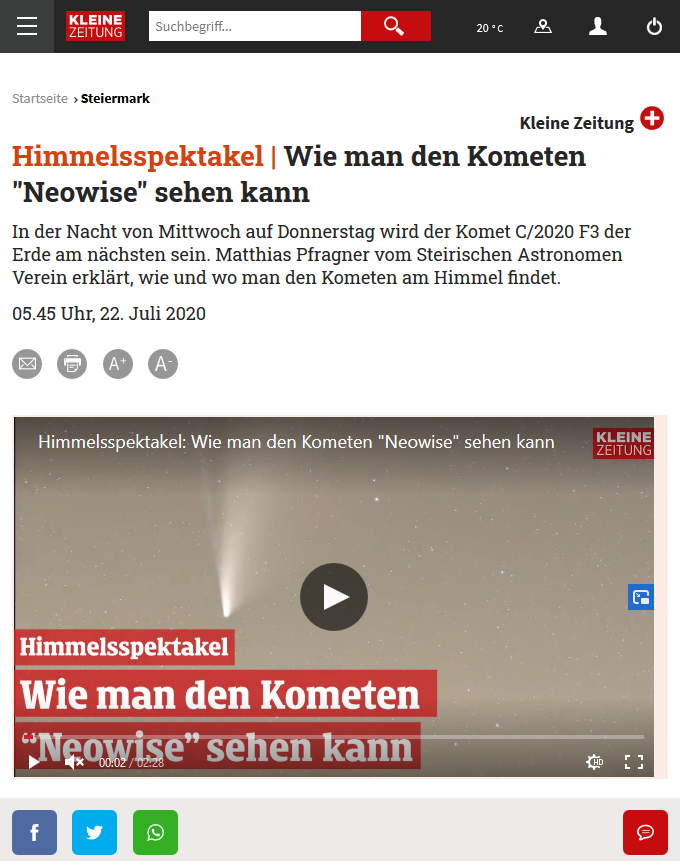
Comet C2020/F3 NEOWISE Update
Finally, after a couple of days, clouds did break up for an unobstructed view of comet C2020/F3 NEOWISE. This time, I left the city area for a quite dark spot (21.3mpss / Bortle 4) at 1600m above sea level. At around 11pm, the comet got clearly visible with naked eye. With binoculars, the comets tail got some structure.
While my cameras did collect images, there was enough time to marvel on the summer milky way and several of the treasures in constellations Sagittarius and Eagle (Lagoon nebula, Eagle nebula, Butterfly cluster, Trifid nebula, …)
As a bonus, there have been lots of meteors to enjoy!
Comet C2020/F3 NEOWISE already visible in the evening!
Yesterday night, before going to bed, I took a brief look at the night sky. Fortunately, the forecast clouds did not yet appear. So I took my binoculars and went up to the top most window of my condo’s stair case, which is facing north.
I could not spot the comet with my bare eyes. Though with binoculars, the comet was a pleasant sight, even though it was low in the suburban light polluted sky. At this moment, the comet was a mere 5.5 degrees above the horizon.
So I rushed back down the stairs and grabbed my camera and a tripod. I intentionally did not use one of my tracking mounts, as I expected the comet to reach the adjacent roof top within a short period of time.
Within a few minutes I could capture a set of images to process. Here are the results, all captured with Sony A99-ii and 70-200mm/f2.8 tele lens at 200mm:
It is obvious that the 30x4s ISO1600 exposures are far better in noise than the 115×2.5s ISO12800 exposures. Apart from that (ignore the color cast and gradients, which result from bad calibration data), a lot of information may be pulled from the stacked images.
Comet C2020 F3 NEOWISE
This years best view of a comet has finally been visible in my region. Weather conditions have been really favorable for a night time spectacle.
Combined with the setting across my home town Graz, viewing from top of Plabutsch (located at the eastern edge of Graz) permitted the comet to rise exactly next to the 2 antennas on the mountain top of Schöckl in 14km distance.
See how remarkably bright the comet is in the wider angle image below. This image was taken with a mobile phone camera! And the comet is clearly visible!
The timelapse video shows the comet rising at 02:38 CEST until mid of nautic twilight at 03:54 CEST. See the amazing pattern of the noctilucent clouds going in waves!
Comet C/2018 Y1 Iwamoto with NGC 2903 Galaxy from the city
It is always frustrating to see good weather pass without the opportunity to do some photography – especially astro-photography. So even if time does not permit a trip to the darker spots in reasonable distance from my home, it is worth a try to setup the telescope on the balcony.
This time, clouds cleared throughout the day (and happend to reappear before midnight). So I had to take the chance to spot Comet C/2018 Y1 Iwamoto. Unfortunately, I was unable to spot the comet through the eyepiece. The sky was far too bright (approximately 18mpss) watching straight over the citys light dome and having a 60% illuminated moon shining bright. Fortunately, through the camera I could make out a smudge, being brighter than the sky.
Processing the 180s subs with 1 hour total exposure time, I could achieve this result (compare to the unprocessed image!):
Image is a composite of 2 stacks (one aligned on stars, second aligned on comet). The comet moved more than 1.5 degrees during the 1 hour capturing time!
Above the comet: NGC 2903 (mag 9 galaxy)
At left: NGC 2916 (mag 12.1 galaxy)
Imaging setup: 800mm f/4.0 Newton, Sony A6000 full spectrum modified, UV/IR block filter, UHC filter, coma corrector (at wrong distance).
20x 180s @ ISO800, darks and flats
Conditions: +2°C, 60% moon, 18-18.5mpss sky in suburban location (with ample street light)
Comets during full moon
After 2 weeks of thick cloud coverage, I had the chance to spend the evening at the observatory. Actually I jumped in to hold the guided tour this evening…
As there was almost full moon and some cloud coverage (which got steadily thinner) I played a bit around with the setup. I thought – deep sky at full moon is a waste of time. But how about the comets 46/P Wirtanen and 38/P Stephan-Oterma? How brigth are the comets still? Would they shine through the moon lit sky?
Well… I could not make out Stephen-Oterma. But Wirtanen was barely (in)visible. I had some other tasks to do, so I attached the camera to the scope and let it run to see, what may be gathered under these conditions.
Despite of the Moon and the corona of Moon, a little bit of the comets was still possible to process from 90 minutes of total exposure time each:
